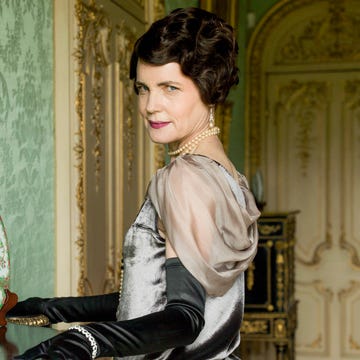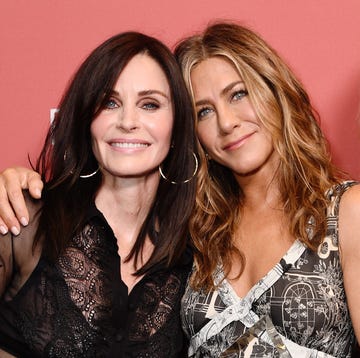In the ever-lengthening roster of celebrities seemingly ageing backwards, Jennifer Lopez is surely leading the pack. Making an appearance via video link at the 2024 American Music Awards, she reminisced about her first appearance at the star-studded event back in 2001, and while her performances across the years have remained as energetic as that first outing, there’s been a subtle shift in her appearance that’s also enhanced that much-coveted JLo glow. The ultra-flattering change? Lightening her hair as she’s grown older.
“While Jennifer Lopez isn’t ‘built’ to be a blonde, if you look at her colouring, maintaining a brunette tone with lighter ends creates both light and depth in the hair, which is really classy,” says celebrity hairstylist, colourist and salon owner Gustav Fouche. “She’s the perfect example of appearing blonde without veering into ashy tones that can make you look washed out. Embracing lighter tones in the hair is youthful, but you don’t need to be blonde from root to tip to get the best effect. Keeping a darker root softens the blonde, making it look a lot more chic,” he explains.
Why you should lighten hair as you get older
“As we age, we lose pigment in our skin, which means that we lose some of our natural warmth,” says Gustav. “While you might have had dark hair that suited you when you were younger, it can look harsher as we get older, and if every hair is the same colour, it can even make your hair look a bit wig-like,” he adds.
What to read next
Before you reach for the bleach, Gustav stresses that you needn’t stage a total hair transformation. “Like JLo, you can still keep those dark tones, but adding lightness to your base makes hair more reflective, which in turn brightens up your face. Think of it like makeup: a little highlighter lifts your complexion and makes everything look softer, and it’s the same with hair colour.”
How to lighten hair as you get older
Gustav’s main line on this is “gradually”. “In order to lift your hair colour, we need to use some form of bleach; it’s the only way to get that lightness,” he says. “I’m conservative with the process as you don’t necessarily want to go light and bright everywhere. I know people who’ve gone from light to dark quickly and they’re quite shocked when they see themselves afterwards.”
Your starting point will determine what’s achievable, says Amelia Evans, colour specialist and head of education at Hare & Bone. “This is all about getting the best consultation to make sure everything is suitable, how long it will take and how to preserve the condition of your hair. If it’s just one shade lighter, it would be easy to achieve within a couple of applications. Bigger changes are better done over a few appointments.”
Good hair days come to those who wait, according to Gustav. “Build lightness slowly and assess what’s looking great, then add to that,” he advises. “On the whole, my clients are happiest when I enhance their colour with balayage techniques and some blonder pieces, rather than going blonde all over. This helps to add texture, too.”
How to find the right lighter shade
One key consideration when lightening hair as you get older is your skin’s natural undertones, as the shade and brightness of your blonde depends on whether you have warm, cool or neutral undertones.
“This can change as you move from your 50s to your 60s to your 70s as well, so keep reassessing it with your colourist. You might not suit a pale blonde at the moment, but there’s no saying that you won’t in the future; it’s just for now your skin might be warm or on the beige side, so you need some brunette tones in your hair to balance that. On the other hand, if your skin tone is cool, all-over blonde can look fabulous.”
From there, Gustav notes that the shade of your eyebrows will determine how light you can go, too – the darker your brows, the more depth you likely need in your hair colour, especially at the roots.
Previewing your new look before you commit is a great idea. “You can have swatches placed against your skin to see what tone of blonde is best suited for you and then you can discuss how to achieve this,” says Amelia.
Should grey hair go lighter, too?
“If you’re going grey, adding some blonde ‘lights’ adds softness,” Gustav says. It’s important to remember, though, that grey isn’t universal; there’s a spectrum of shades to consider. “Some people have more of a steel tone, some a darker tobacco or a blue hue, so skin tone matters here, too. For example, if you have a warm skin tone, a steely grey might be too much of a contrast; you’d be better off with a warmer grey or blonde.”
A great celebrity inspiration is Andie MacDowell, says Amelia. “She looks insanely good! The way she’s embraced her natural grey and enhanced the front with a slightly softer warmer blonde tone looks so nice on her skin.”
The best haircare for lightened hair
Gustav’s two must-haves? “Moisture and protein. Ideally, lots of both, but depending on the texture and strength of your hair, you might need more protein, which is often the case if your hair is finer. If your hair’s thicker and coarser, you’ll definitely need to infuse hair with more moisture,” he says. He recommends K18’s new spray-on in-salon treatment as the perfect cocktail of both (award-winning colourist Francesco Merico recently used this on my significantly lightened hair and it gave it a noticeable condition boost, even post-bleaching).
Gustav also advocates being especially disciplined with using heat protection before styling hair with heated tools and hot brushes, as “lightened hair can be vulnerable to colour change when heat is applied to it; protecting it is crucial to maintain both colour and condition.”
As for what to avoid, you might want to swerve silicone-based hair products, in Gustav's opinion. “Silicone dehydrates your hair, which is bad news as the bleach used to lighten hair already has a dehydrating effect,” he warns.
To keep lightened hair vibrant and glossy, shop our silicone-free blonde-friendly haircare picks below (one of which JLo used before this year’s Golden Globes awards – you’re in stellar company).
Gustav’s very own tonic for stronger, softer hair. He recommends applying the protective amino acid- and antioxidant-loaded formula to bleached hair before every wash to counteract any damage, or gently working it through hair from root to tip with a wide-tooth comb and leaving it on overnight for a more intensive treatment.
Designed for fine yet dry coloured hair, this shampoo helps to slow colour fade, with jojoba oil to soften damaged hair without leaving it looking too slick. The aromatherapeutic fragrance blend (lavender, bergamot and patchouli) creates a spa-like vibe in your shower too. In short, it’s a pleasure to use, rather than a chore.
Living in a hard water area can take the shine out of your hair colour (no) thanks to heavy metal deposits in water. Short of perusing Rightmove, this conditioner helps to neutralise said metals, making hair all the silkier and stopping blonde and lightened hair going brassy quite so quickly (it has the familiar violet tone you’ll recognise in blonde-brightening purple shampoos). Reishi mushroom and rose extracts also work in tandem to combat environmental and UV damage that can cause lightened hair to fade.
Hair stylist and salon founder Edward James rates this strengthening protein-, keratin- and vitamin-loaded intensive treatment for brittle, bleached strands. It offers incredible smoothing prowess, and there’s no reason to limit its use to your evening routine (although the lavender and chamomile scent may well have you nodding off).
JLo’s hair stylist, Chris Appleton, ensured her lengths were snag-free with this very brush before this year’s Golden Globes, likely because it nixes knots with very little drama and no damage, a quality that’s especially key for delicate lightened hair. Go especially gently on the ends as these are the lightest, oldest sections of your hair and the most prone to damage and fraying.
Rich in essential fatty acids, celebrity colourist Josh Wood devised this deeply nourishing hair oil after his clients noticed their hair becoming coarser with age, especially those with grey, silver and lighter tones. It can be used as an overnight treatment, smoothed on to lengths and ends before blow drying or applied to dry hair to combat frizz and infuse porous, lightened hair with omega 3-rich plant oils that look and feel surprisingly lightweight (a little goes a long way).
A reformulation of the brand’s much-loved blow-dry balm, this cream has a lot to give for lightened hair especially. It protects hair from heat damage up to 232°C and helps retain its shape and style for up to three days, meaning fewer washes and less heat styling, both of which help you to hold on to your colour for longer. It’s also proven to actively prevent split ends from forming, plus it minimises frizz. The main player in the seven-oil blend is nangai oil, which is essentially a natural substitution for silicone, delivering sheen and swish without the dehydrating downsides.




















